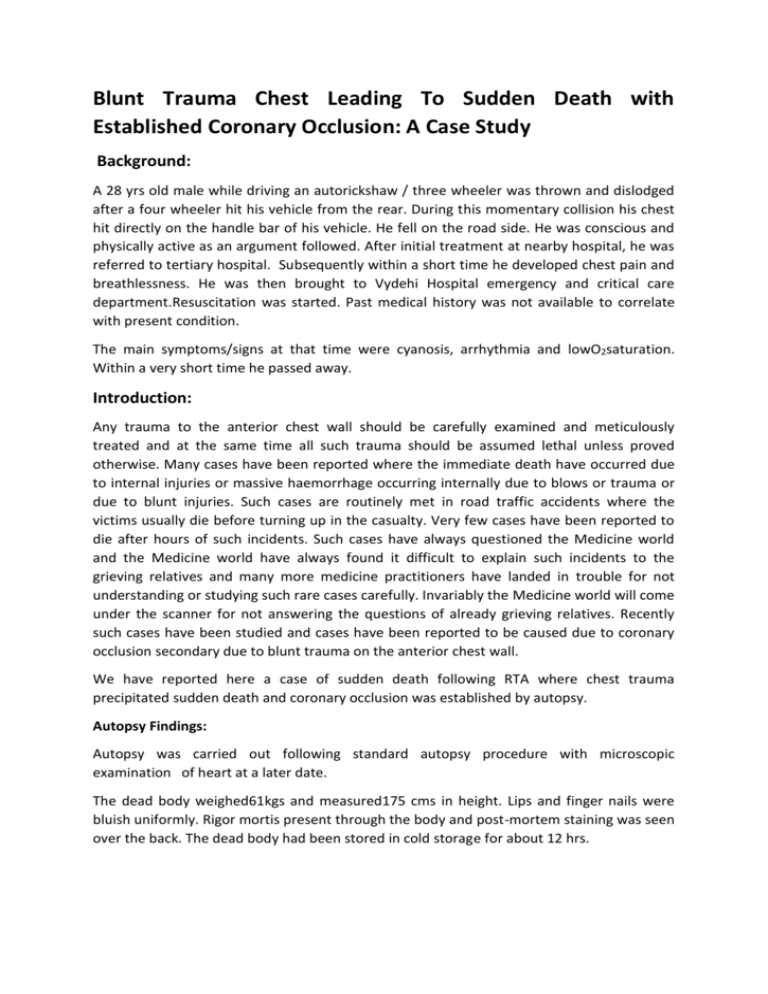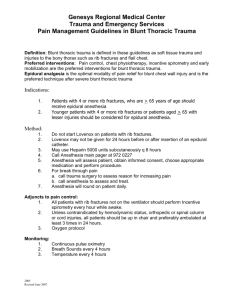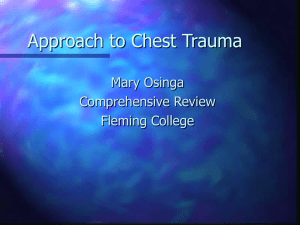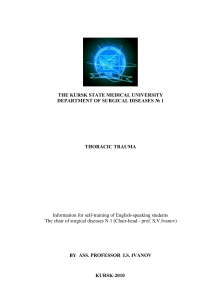Blunt Trauma Chest Leading To Sudden Death with Established
advertisement

Blunt Trauma Chest Leading To Sudden Death with Established Coronary Occlusion: A Case Study Background: A 28 yrs old male while driving an autorickshaw / three wheeler was thrown and dislodged after a four wheeler hit his vehicle from the rear. During this momentary collision his chest hit directly on the handle bar of his vehicle. He fell on the road side. He was conscious and physically active as an argument followed. After initial treatment at nearby hospital, he was referred to tertiary hospital. Subsequently within a short time he developed chest pain and breathlessness. He was then brought to Vydehi Hospital emergency and critical care department.Resuscitation was started. Past medical history was not available to correlate with present condition. The main symptoms/signs at that time were cyanosis, arrhythmia and lowO2saturation. Within a very short time he passed away. Introduction: Any trauma to the anterior chest wall should be carefully examined and meticulously treated and at the same time all such trauma should be assumed lethal unless proved otherwise. Many cases have been reported where the immediate death have occurred due to internal injuries or massive haemorrhage occurring internally due to blows or trauma or due to blunt injuries. Such cases are routinely met in road traffic accidents where the victims usually die before turning up in the casualty. Very few cases have been reported to die after hours of such incidents. Such cases have always questioned the Medicine world and the Medicine world have always found it difficult to explain such incidents to the grieving relatives and many more medicine practitioners have landed in trouble for not understanding or studying such rare cases carefully. Invariably the Medicine world will come under the scanner for not answering the questions of already grieving relatives. Recently such cases have been studied and cases have been reported to be caused due to coronary occlusion secondary due to blunt trauma on the anterior chest wall. We have reported here a case of sudden death following RTA where chest trauma precipitated sudden death and coronary occlusion was established by autopsy. Autopsy Findings: Autopsy was carried out following standard autopsy procedure with microscopic examination of heart at a later date. The dead body weighed61kgs and measured175 cms in height. Lips and finger nails were bluish uniformly. Rigor mortis present through the body and post-mortem staining was seen over the back. The dead body had been stored in cold storage for about 12 hrs. External findings: 1. Contusion noted in precordial area measuring 4x3cm. 2. Contusion seen in outer aspect of right thigh measuring 19x6.5cm. 3. Abrasion over back of right elbow measuring 5x5cm. All injuries are dark red in colour and ante mortem in nature. Internal findings: Chest wall dissection showed, transverse fracture of sternum between 3rd& 4thsternibrae (pieces), with adjoining extravasation of dark red coloured blood. Lungs: right lung showed contusion in the apical region of upper lobeand interlobar fissure margins of lower lobe. Left lung was unremarkable. Weight of Right lung- 921gms and Left lung- 482gms. Pericardium- contused, Heart weighed- 348gms, Right atrium surface showed contusion anteriorly. Left Ventricle surface showed haemorrhage anteriorly. On dissection of heart, interventricular septum showed pallor. Left anterior descending artery showed block with reddish brown colour clot, 2cms from its origin. Other coronaries were intact with atherosclerotic narrowing(LAD? haemorrhagic plaque). Other organs were normal. Histology- Microscopic findings: The left coronary artery shows a fibroatheroma, with an evolving adherent thrombus partially obliterating the lumen. Section from the pieces of lung tissue show oedema fluid with few alveoli and foci of haemorrhage. Impression: pulmonary oedema with haemorrhage and atherosclerotic changes of Left coronary artery. Fractured Sternum Right lung - interlobar fissure margin contused Arrow showing Haemorrhagic spots over anterior wall of left ventricle. Arrow showing Reddish brown clot in Left Anterior Descending Artery. Microscopic findings: Plate 1. In scanner view: Intimal proliferation was noted. - Plate 2: High Power: Intimal proliferation, specs of calcification and cholesterol clefts were noted. Plate 3: Oil Immersion: Intimal Proliferation. Blood clot adherent to endothelial lining. Discussion: The following case was one of the rarest of the rare case as the death occurred 3 hours after the incident. Many other cases have occurred and have been reported but none of the death reports have been mentioned to occur after such a prolonged time. The following sequential events may have occurred and may have caused this catastrophic event: Conclusion: Such events can be induced or precipitated by a blunt force. But whether such condition is seen in pre-existing coronary diseases or is completely caused by such events in itself is the question of the hour. Such questions need further studies to be conducted and confirmed. References: 1. Hugar, B. S., Shetty, H. S., Yajaman, G. C. P., & Rao, A. S. (2014). Death Due to Coronary Artery Insufficiency Following Blunt Trauma to the Chest.Journal of forensic sciences, 59(3), 830-832. 2. Guldner, G. T., & Schilling, T. D. (2005). Coronary artery occlusion following blunt chest trauma: a case report and review of the literature. CJEM, 7(2), 118-23. 3. Mastroroberto, P., Di Mizio, G., Colosimo, F., & Ricci, P. (2011). Occlusion of left and right coronary arteries and coronary sinus following blunt chest trauma.Journal of forensic sciences, 56(5), 1349-1351. 4. Wiens, S. E. Acute Myocardial infarction after Blunt Trauma: lsraeli Journal of Trauma, Intensive Care and Emergency Medicine Vol 2, No. 3, November 2002 5. Douglas, R. J. (2011). Sudden cardiac death following blunt chest trauma: commotio cordis. World Journal of Emergency Medicine, 2(3), 234-236. Corresponding Address: Dr. Geetha KB, Post Graduate, Department of Forensic Medicine, Vydehi Institute of Medical Science & Research Centre, Bengaluru. Email: dr_geethakb@yahoo.co.uk Phone: +91 9449671777 Authors: 1. Dr. Geetha KB, Post Graduate, Department of Forensic Medicine, Vydehi Institute of Medical Science & Research Centre, Bengaluru. 2. Dr. Shashidhar S , Post Graduate, Department of Pathology, Vydehi Institute of Medical Science & Research Centre, Bengaluru 3. Dr. Padmini Hannah Noone, Associate Professor, Department of Forensic Medicine, Vydehi Institute of Medical Science & Research Centre, Bengaluru 4. Dr. Sudhamshu Raj Sharma, Professor & Head, Department of Forensic Medicine, Vydehi Institute of Medical Science & Research Centre, Bengaluru











